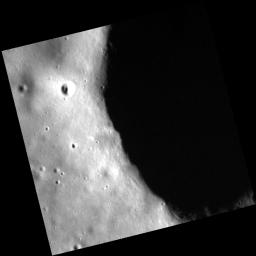
|
Darkness Falls Across the Land
- Click the image above for a larger view
- Full-Res JPEG (623 x 623) (25.4 kB)
- Full-Res TIFF (623 x 623) (388.7 kB)
Caption:
Today's image features the edge of a relatively small (~10 km) diameter crater northwest of Copland crater. The bowl shape of this simple crater results in a particularly dramatic shadow at high incidence angles.
This image was acquired as part of the MDIS low-altitude imaging campaign. During MESSENGER's second extended mission, the spacecraft makes a progressively closer approach to Mercury's surface than at any previous point in the mission, enabling the acquisition of high-spatial-resolution data. For spacecraft altitudes below 350 kilometers, NAC images are acquired with pixel scales ranging from 20 meters to as little as 2 meters.
Date acquired:
August 03, 2014
Image Mission Elapsed Time (MET):
49375560
Image ID:
6803045
Instrument:
Narrow Angle Camera (NAC) of the Mercury Dual Imaging System (MDIS)
Center Latitude:
39.83°
Center Longitude:
68.58° E
Resolution:
11 meters/pixel
Scale:
This image is 5.7 km (3.5 mi.) across.
Incidence Angle:
73.1°
Emission Angle:
4.9°
Phase Angle:
78.0°
Background Info:
The MESSENGER spacecraft is the first ever to orbit the planet Mercury, and the spacecraft's seven scientific instruments and radio science investigation are unraveling the history and evolution of the Solar System's innermost planet. During the first two years of orbital operations, MESSENGER acquired over 150,000 images and extensive other data sets. MESSENGER is capable of continuing orbital operations until early 2015.
For information regarding the use of images, see the MESSENGER image use policy .
Cataloging Keywords:
| Name | Value | Additional Values |
|---|---|---|
| Target | Mercury | |
| System | ||
| Target Type | Planet | |
| Mission | MESSENGER | |
| Instrument Host | MESSENGER | |
| Host Type | Orbiter | |
| Instrument | Mercury Dual Imaging System (MDIS) | |
| Detector | Narrow Angle Camera (NAC) | |
| Extra Keywords | Crater, Grayscale, Radio, Shadow | |
| Acquisition Date | ||
| Release Date | 2014-10-08 | |
| Date in Caption | 2014-08-03 | |
| Image Credit | NASA/Johns Hopkins University Applied Physics Laboratory/Carnegie Institution of Washington | |
| Source | photojournal.jpl.nasa.gov/catalog/PIA18737 | |
| Identifier | PIA18737 | |
